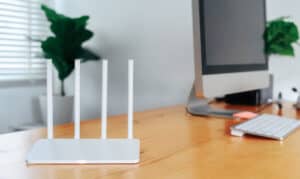
You might need to change your NAT type to “open” to enjoy smooth online gameplay on your PS4 or other devices because a strict NAT is too limiting. For example, you might not be able to host a game or use the voice chat feature. So, how do you change the NAT type on your router for a better connection?
There are three methods to change your NAT type. The first and most popular method is port forwarding. The second and most accessible is enabling UPnP, and the third is to turn on DMZ.
All methods work perfectly, and we’ll cover them in detail below. Read on to find out which way works best for you.
Method #1: Port Forwarding
Port forwarding is the most popular method to change the NAT type on a router. Forwarding ports on a router let it get outside traffic inside your network. You can comfortably run a game server, mail server, access your PC remotely, etc. Here are the steps for port forwarding.
- Open a browser on your PC.
- Enter your IP address into the browser’s search bar and press the Enter key.
You may find the IP address on a sticker at the back of the router. - Type the username and password to sign in to your router’s control panel.
- Try inputting “admin” as username and leaving the password blank.
- Locate the “Port Forwarding” tab.
The steps to find the port forwarding tab depend on which router you have. Mostly, the tab might be within other settings – like “Advanced Setup“, “Network“, or “Wireless“. It may also be in a different name, such as “Forwarding“, “Port Triggering“, or “Port Range Forwarding“. - Click on “Add Customer Service” or “Add New” to create a rule or service.
- Enter a name to help you identify the rule you’ve created above.
- Type the port number you choose to forward.
- Choose either TPC or UDP port as the forwarding protocol.
- Enter your IP address into the field labeled “IP Address“.
- Save these changes by clicking on “Save” or “Apply“, depending on your router.
Method #2: Turn on UPnP
UPnP stands for Universal Plug and Play, and this service makes things easier by facilitating automatic port forwarding. Here are the steps to enable UPnP.
- Connect your PC to the router using an Ethernet cable.
- Open a browser on your computer.
- Enter your IP address on the search bar and hit the Enter key.
- Fill in the login credentials.
- Locate the UPnP settings.
- Enable UPnP and restart your router to save the changes.
Method #3: Turn on DMZ
The Demilitarized Zone (DMZ) feature allows your router to forward all the traffic incoming from the internet to specified devices. However, this convenience comes at a significant security risk since it disables your router’s firewall protection.
We recommend that this method be your last resort. Follow these steps to enable DMZ.
- Open your Windows Control Panel on your computer.
- Click on “Network and Internet” >”Network and Sharing Center“.
- Click the link under “Access Type“.
- Select “Properties“.
- Double-click on “Internet Protocol Version 4 (TCP/IPv4)” under “Networking” to open the IPv4 properties. You’ll see everything connected automatically if you’ve not changed the settings before.
- Manually enter your IP address and Subnet Mask into the input box.
You’ll find the details needed by typingipconfigto command prompt. - Navigate to your router’s control panel.
- Find and activate the DMZ option, often under the “WAN” tab.
- Enter your IP address there and any other information required.
- Save the settings on the router and then restart your computer.
Conclusion
We’ve explained three methods to change the NAT type on your router: port forwarding, turning on UPnP, and turning on DMZ. You must log in to your router’s control panel to apply the changes in each method, and all three ways are reliable and easy to use to get better connections.
Additionally, we’ve learned that DMZ leaves your IP address public, exposing you to the entire internet. However, you’ll enjoy better connections, which leaves you vulnerable security-wise.
We recommend using one of the first two methods instead of the third, likely to jeopardize your data security.








